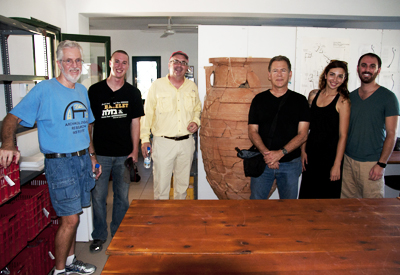Graduate Student Accepted to Ceramic Petrology Course in Athens, Greece

San Diego, March 1, 2016 — UC San Diego archaeological anthropology Ph.D. student Matt Howland has been accepted to participate in a two-week postgraduate training course in petrology and its applications to the study of archaeological ceramics. The course, Introduction to Ceramic Petrology, is scheduled for May 30-June 10, and it will take place at the Fitch Laboratory for Science-based Archaeology in the British School at Athens, Greece. According to organizers, Howland’s application was “ranked highly among a large number of requests from all over the world.”
Howland is a Ph.D. student in Anthropology and participant in the NSF IGERT-TEECH training program for graduate students interested in cultural heritage engineering and diagnostics. His research interests include archaeological mapping, 3D visualization and modeling, spatial analysis, and landscape archaeology. Howland specializes as a balloon photographer, photographing archaeological sites for the purposes of documentation, analysis, and mapping. He also works with Structure-From-Motion (SfM) techniques for creating archaeological models quickly and inexpensively. His supervisor is Prof. Tom Levy in the Levantine Archaeology Lab and the Center for Cyber-Archaeology and Sustainability (CCAS), a partnership between the Division of Social Sciences and the Qualcomm Institute at UC San Diego. Howland has worked on the Edom Lowlands Regional Archaeology Project, and he used balloon photography at sites across the Southern Levant, including Petra, Khirbat Faynan, Tel Akko, and Qatzrin.

In 2013 Howland participated in the first International Workshop on Virtual Archaeology, Museums, and Cultural Tourism in Delphi, Greece. His paper, “Low-Altitude Aerial Photography and Structure from Motion: Documenting the Past for Preservation and Presentation,” mirrored his doctoral work collecting geo-referenced data in Jordan used for daily excavation recording, mapping of sites, and 3D visualization that can also be used by visualization systems for 3D models to be used in museums or in the field. After the Delphi workshop, Howland and others visited the pottery lab at the INSTAP Study Center for East Crete. (Above: Howland is pictured second from left with UC San Diego colleagues at the INSTAP Study Center.)
The Fitch Laboratory has pioneered the application of thin-section petrology to ceramic research in Greece and is today the leading petrography center in the region. Over the last four decades the lab has built up an unparalleled reference collection of archaeological and geological samples, relevant not only to Greece but the wider Eastern Mediterranean region. The Fitch Lab also provides premium facilities for science-based archaeological research across the Mediterranean, promoting the British School’s ability to link the humanities and social sciences with the natural sciences. The laboratory’s mission is to support the study of material culture, society and landscape, from early prehistory to modern times, through the integrated use of scientific methods and techniques.
Related Links
